Motorola Droid X2 Review - A Droid X with Tegra 2
by Brian Klug on July 7, 2011 8:31 AM ESTDisplay - qHD RGBW PenTile
Probably the most significant change (other than Tegra 2) between the X and X2 is of course the display. As we mentioned before, that has been upgraded from a 4.3” FWVGA (854 x 480) IPS LCD to a qHD (960 x 540) LCD with the same diagonal size. What’s special about the X2’s screen, however, is that it comes with an RGBW PenTile subpixel rendering layout.
We’ve talked about the RGBG PenTile subpixel structure before in the context of devices which came with AMOLED or Super AMOLED displays. The chief complaint back then was that black text on webpages and UI elements didn’t always look super sharp. RGBW is a different layout with different purpose, and dare I say different results.
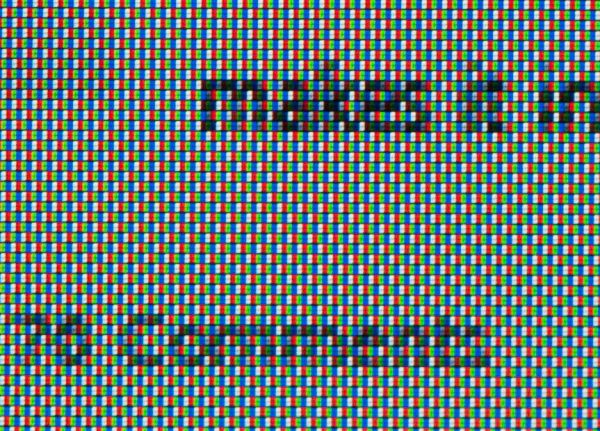
A 100% crop of the AT homepage on the Droid X2's RGBW display
As its name implies, RGBW PenTile includes a fourth, white, subpixel. The idea here is that light throughput for the panel can be vastly increased by simply adding a subpixel with no color filter. That increase in throughput then can be exploited to either get equivalent visual brightness with less backlight power, or you can crank things up all the way and get extreme brightness for the same backlight power. That translates to power savings most of the time, and extremely bright whites other times when you need it. It actually does make a lot of sense, especially when you consider things like browsing webpages which is still largely black text on a white background.
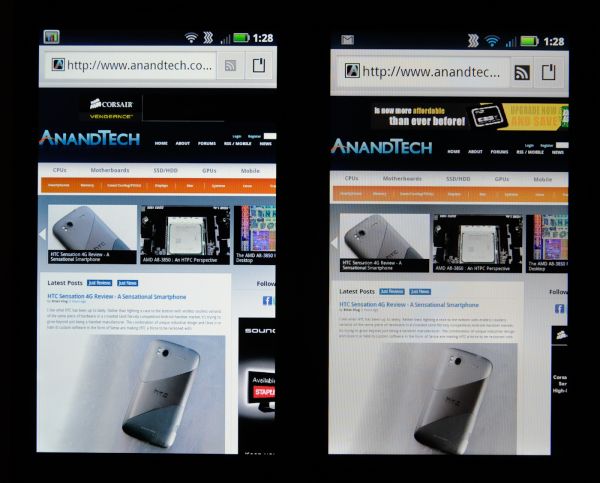 Left: Droid X2, Right: Droid X
Left: Droid X2, Right: Droid X
On webpages, RGBW actually looks pretty good, with black text being nice and sharp on a white background. This is one place where RGBG just never could do a perfect job, but RGBW does. I actually have no problem with RGBW for black text on white backgrounds.
Droid X:
Droid X2:
The only place you can still dramatically tell that this is PenTile is either by looking at regions that are solid green, or red. At green in particular, you can see a bit of that grain from the subpixel structure - green is most visible because visual acuity peaks in the green. Red is also sometimes also shows a bit of that telltale grain, but nothing too dramatic. Human visual acuity isn’t very good for blue, so that looks pretty homogeneous.
In our tests, the X2 results definitely show how much having that white subpixel can help.
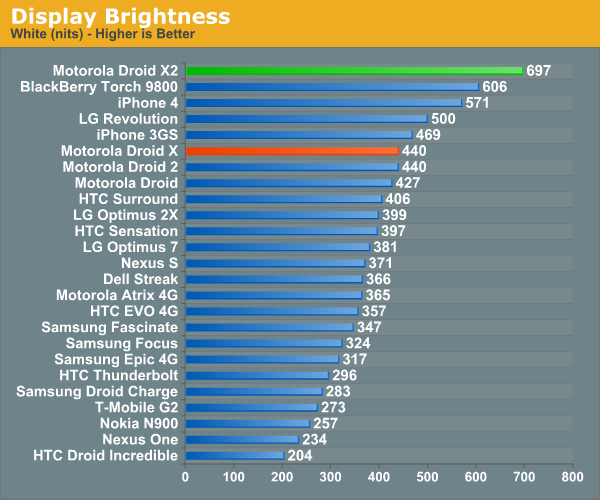

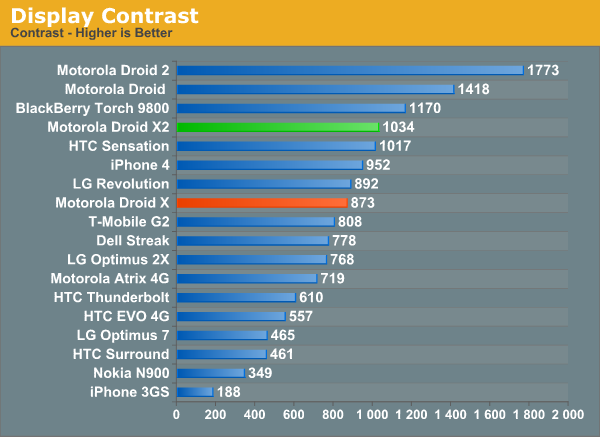
Motorola has had a pretty steady track record for putting great displays in their devices, going all the way back to the original Motorola Droid which included an IPS display. It’s nice to see that they haven’t compromised with the X2 either.
We’ve also been measuring display brightness and white point at 25% brightness increments on displays lately, and the X2 is no exception from this treatment. Alongside the Motorola Droid X, the X2 looks substantially bluer. Looking at the white point on the X2 it’s easy to see where that comes from. At 7500K it’s closer to sanity than the 8500K for Super AMOLED Plus, but still not quite perfect.

Moving onto the brightness (white and black) graph, we can see something finally reminiscent of a LCD, showing steady contrast as black and white both climb in a nice linear fashion as we ramp up brightness. The Droid X2 stays pretty contrasty, moreso than we originally measured the Droid X as being, but still not quite chart topping.
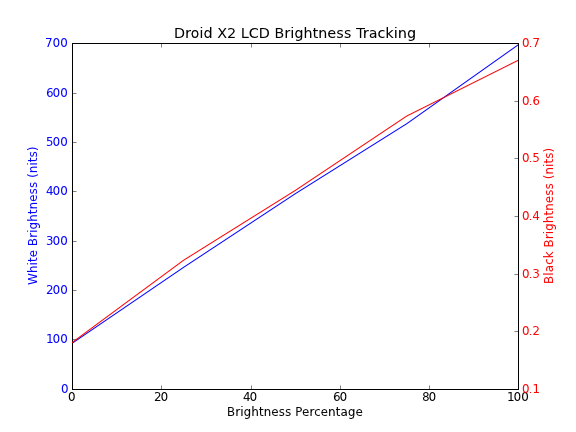
Viewing angles on the X2 seem subjectively better than the original X. You can see colors on the X fade off and turn strange at the extreme vertical angles and a bit as well at horizontal extreme angles. I don’t remember the X looking this bad, it could be that the device I borrowed has a worse panel than the original X we were sampled last year.
Outdoors the X2 seems pretty readable, no doubt thanks to having that white subpixel and extremely high brightness. Even in the extremely bright, direct Arizona sunlight the X2 seemed a bit more readable than other devices from recent memory.
Again the real nice thing about the X2 display is that qHD resolution which makes it able to both have a bit more text smoothing on webpages, and also just look better. I was especially thankful for that extra resolution when using things like remote desktop and maps from the X2, as a result, things on similarly sized WVGA displays look cartoonishly huge.


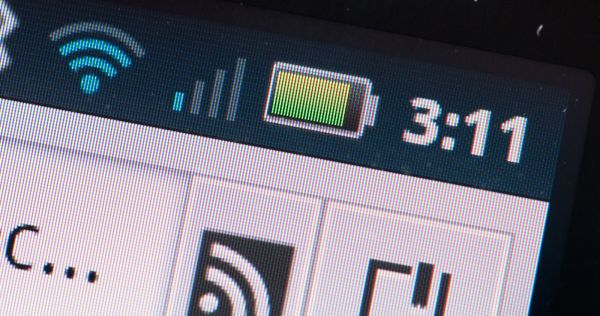
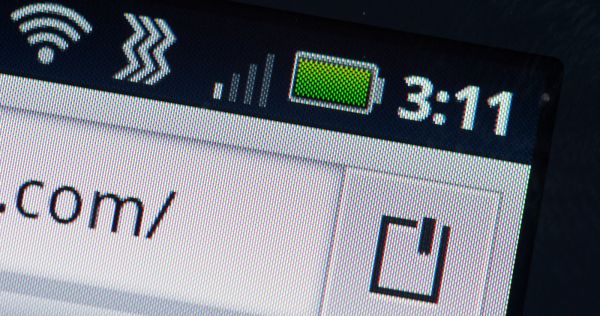






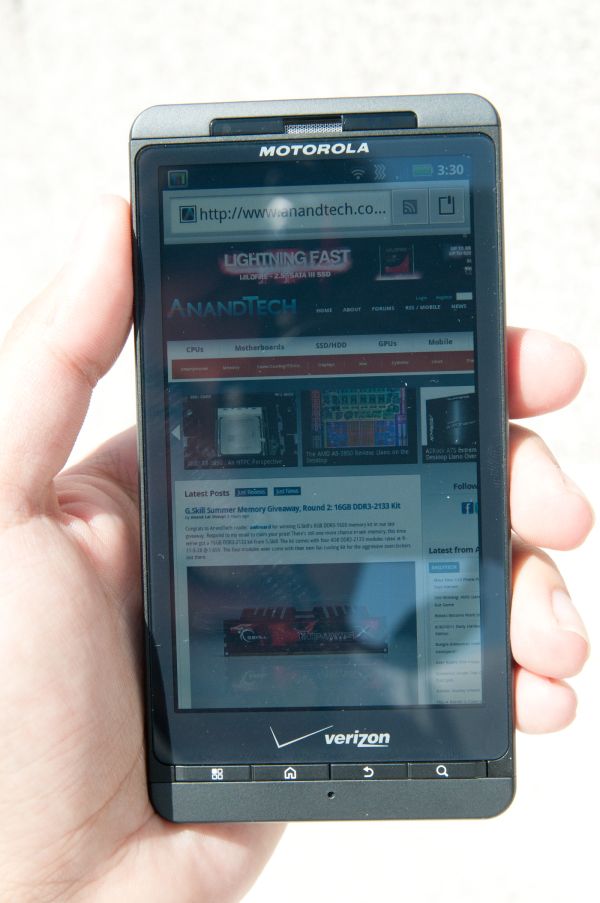








72 Comments
View All Comments
anandatar - Thursday, July 7, 2011 - link
So yeah, I know, Anandtech is a US blog.Still I'm surprised there is no comparison to the Galaxy S 2 - I was already surprised before by this but nothing has changed.
The main reason is because ALL the phones in the comparison look pale when compared with the S2.
It's (much) faster than any of the Tegra2 based devices.
It has more ram.
It's (much) lighter (there's no xperia either)
It's (much) thinner (there's no xperia either)
it's camera still picture is second to the N8 only
it's camera video recordings are above average (not blowing others out of the water tho - in 1080p it's zoomed and focusing is slower - in 720p its awesome)
it's battery life is (much) improved too
in fact, on the paper, only the resolution (800x480) is lower than the other phones (that sometimes have qHD)
Not only that, but it's also the first phone I'd use instead of an iPhone - it's that much better that it makes sense to switch. But I wouldnt settle for less.
jmcb - Thursday, July 7, 2011 - link
Glad you like the GS2 so much....If you know all this, why do you need to see a comparison? Check other sites, they do compare the GS2 with other phones...Imma help you out.... phonearena is one site that does. phonedog is another...
NeoteriX - Thursday, July 7, 2011 - link
You mentioned in your HTC Sensation review that with a little digging, you were able to come up with the camera sensor used there -- "Samsung’s 8 MP S5K3H1GX 1/3.2” 3264x2488 CMOS sensor with 1.4 µm square pixels "Though the sensor isn't the only thing as you mentioned (lens, etc.), it's useful to compare stated sensitivities, pixel sizes, etc. across the different current phones as well as generationally. I still feel like the gold standard is the iPhone 4 with its 1.75 µm pixel sites and BSI Omnivision sensor.
Do you have this information for the Droid X and X2? How does one generally determine this? I'd love to be able to figure it out for my Evo 3D.
munky - Thursday, July 7, 2011 - link
Iphone4 is by no means the gold standard. Also, there's plenty of variables affecting sensor performance which wouldn't be obvious just by looking at pixel pitch, not to mention how the image processing algorithms affect the final outcome. Unless you suggest AT start evaluating sensors with RAW data a la dxomark, I'd much rather they focus on comparing actual photos as opposed to numerical specs.NeoteriX - Thursday, July 7, 2011 - link
I agree that specs aren't the whole picture, but I do think it provides useful insight to augment the results one sees in practical testing -- things like being able to tell how much of the improvement is image processing, what generation the sensor is and recently of development, and seeing if improving the image quality/sensors used is actually a priority for certain manufacturers. More information never hurts and it helps understand the story -- for example, when digital cameras were undergoing the megapixel race one or two years ago, it was clear that low light quality was degrading and pixel sites helped explain that story.At any rate, I'm no expert on the state of cellphone cameras, but I will respectfully disagree with you on the iPhone 4 -- no other non-camera-phone smartphone (i.e., the Sony/Nokia/etc. type phones with real digital camera level optics and sensors built in, xenon-flashes the whole 9 yards) *I've seen* has the kind of low-light sensitivity and all-around flexibility of the iPhone 4.
It's likely a combination of the relatively large sensor sites, the large fixed aperture of the lens, the BSI CMOS design, and good image processing, but Android mfrs still have their work cut out for them over a year after the iPhone 4 release -- I'd be interested in hearing what other phone is better in low-light and all-around capability, because I certainly haven't seen it.
Exodite - Thursday, July 7, 2011 - link
The new Xperia series (arc/neo/pro/play) seems a good fit, especially considering that the iPhone 5 is slated to use the same sensor as those handsets.Anyway the criteria you use for comparison are rather humorous, as it reads like the iPhone 4 having the best camera - as long as you disregard those that are better?
HTC is generally known to ship shitty cameras but I'd say both foo, bar, beep and bloop - to name those at the top of my mind - offer some excellent solutions for those who want decent images from their smartphones.
(As a side note to Anandtech - your spam filter sucks! Horribly.)
Exodite - Thursday, July 7, 2011 - link
Feel free to replace foo, bar, beep and bloop with the names of big smartphone manufacturers that aren't HTC.I would do it myself, if that wouldn't mean getting caught in the spam filter.
NeoteriX - Thursday, July 7, 2011 - link
That's fair although I wouldn't call my criteria bogus ;)The vast majority of cell/smartphones are those built around sensor/lens/IC SOCs primarily built for mobile applications, they feature LED-based flashes--in essence, they are known to be significant compromises in the world of digital imaging because they are, in other words, phones first, cameras second.
Then, there is a small minority of cell phones that are essentially cameras with phones attached to them -- SonyEricsson C-902, Nokia N82, etc. that feature sensors and lenses pulled from traditional cameras, but with phone functionality -- we're talking about large sensors, camera glass, and xenon flashes intended for P&S digital camera applications and not mobile.
I've heard good things about the new Xperia Arc with the Exmor R BSI sensor, but it hasn't been released in the US yet and neither has the iPhone 5... thus my position that the iPhone 4 leads the pack.
Exodite - Thursday, July 7, 2011 - link
I would say my arc does decent pictures, though perhaps I'm spoiled by the fact that my better half uses a Nokia N8. Color accuracy is good but the focus area is unfortunately very narrow which makes the pictures less good than they could be.The Samsung Galaxy S2 is arguably better, end results considered.
Anyway, I hope the iPhone 5 does end up using the same sensor as the Xperia line as it'd be interesting to see what a different hard/software solution would do with the same sensor.
Then there's stuff like the Motorola Milestone which also have a great camera, considering.
Would an N8 qualify, or is that too a camera first?
Because from my standpoint I can see something like the Altek Leo being a camera first and phone second but I'd still consider anything in a normal housing to be a phone first.
munky - Thursday, July 7, 2011 - link
Have you seen the photos taken with the Nokia N8? They are cleaner that those from iphone4, not to mention more natural looking due to lack of over-sharpening and over-saturation. The iphone4 may be good compared to a crappy phonecam, but it is definitely not the best.